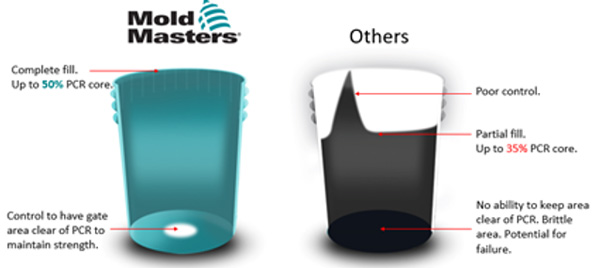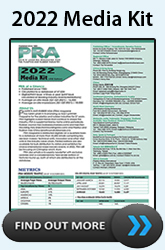Higher PCR content in pails through co-injection
Supplier of hot runners, controllers, auxiliary injection and co-injection systems Mold-Masters extends its service to both bio-resins and post-consumer recycled (PCR) materials. Sustainability is not only driven by government regulations, but consumer demand and environmental awareness around the globe is driving more companies towards sustainable applications. When it comes to PCR and sustainable applications, the Canadian company adds it has the proven capability.
With co-injection, there is the ability to combine two separate resins into a single three-layer melt flow. This allows the injection of high PCR content as the core layer up to 50% of total part weight without sacrificing part quality or cycle time.
In a recent production application, Mold-Masters says it implemented a two-cavity co-injection system for producing 5 gal. (20 L) pails. Each of these 700 g pails incorporated 50% PCR as the core layer. This sustainable solution has the potential to generate significant savings for the moulder (based on current prices) by reducing the use of virgin material and TiO₂ (compared to traditional mono-layer pails). These significant savings and favorable ROI mean that sustainability initiatives can also make good financial sense, the company adds.
Mold-Masters first introduced this capability as part of its co-injection technology back in 2015. What sets Mold-Masters apart is its control, which allows precise control distribution and thickness of the core layer. This is what allows Mold-Masters to inject a higher percentage of PCR content than competitive systems. Where Mold-Masters can inject up to 50% PCR core, many competing systems are limited to incorporating up to 35% which could limit sustainability targets and can significantly affect implementation ROI.

Uniform leading-edge control also allows Mold-Masters to achieve more consistent and fuller core fill. Its patented “fold-over” capabilities is a technical advantage that enables it to achieve the highest core percentage and ensure uniform distribution and complete coverage of PCR resins (prevents contact of PCR with product).
Another significant difference is its ability to position the core where required. For example, on packaging applications customers may prefer to keep any PCR core away from the injection point to avoid moulded in stresses which can cause brittleness and result in drop test failures.
One of the major advantages of Mold-Masters Co-injection technology is that there is no penalty to cycle time and existing tooling can be re-used. A variety of materials can be combined although those with similar melt temperatures are ideal for compatibility. Many applications are those that utilise the same material (ex: 50% virgin HDPE, 50% PCR HDPE). However, its thermally isolated manifolds make it possible to combine two thermally different resins.
(IMA)Subscribe to Get the Latest Updates from IMA Please click here
©2022 Injection Moulding Asia. All rights reserved.














